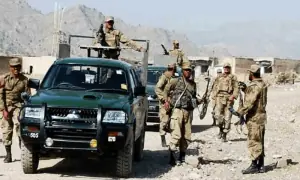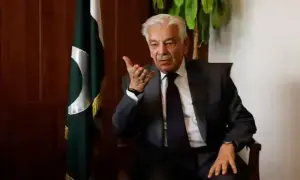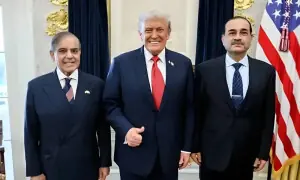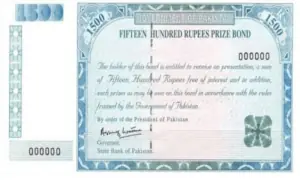Situationer: Imran’s threat to dissolve assemblies and what comes next
Pakistan Tehreek-e-Insaf Chairman Imran Khan has spent the last seven month’s in frenzied political activity. He has conducted over 100 public gatherings this year following his ouster in a vote of no confidence in April including periods when it became a daily affair. His long march to Islamabad — or the Haqeeqi Azadi March — was ostensibly to achieve one goal: to force the PML-N led coalition government to announce early elections.
With Saturday’s ‘power show’ in Rawalpindi ending without the fulfilment of this goal, Imran needed some saving grace — not as much for himself but for his beleaguered supporters. This came in the form of an announcement that his party would be resigning from the national and provincial assemblies, resulting in the dissolution of at least the Khyber Pakhtunkhwa and Punjab assemblies where PTI has the requisite numbers.
This provided ‘political hope’ to his supporters while also allowing Imran to reinforce his narrative that he wouldn’t be part of the ‘corrupt system’.
Resignations and dissolution
Can Imran’s latest gambit pave the way for general elections? His announcement has kickstarted a political, legal and constitutional debate, enabling him to dominate headlines over the issue as political parties scuttle over the math of it all.
This begins with calculating the number of seats that PTI has in the four provincial assemblies: whether the PTI has enough numbers for the dissolution of the assembly in question resulting in fresh elections, or if the resignations would result in by-elections.
Considering the political calculus and the situation as it is evolving, the situation might not be as straightforward as the PTI would like its supporters to believe.
Punjab and Khyber Pakhtunkhwa assemblies
Imran has his sight set on the two pprovincial assemblies where the PTI is in the government. In the Khyber-Pakhtunkhwa, they also have the chief minister, Mahmood Khan.
In Punjab, the situation is slightly difference where PTI is in an alliance with the PML-Q, with Chief Minister Pervaiz Elahi belonging to the latter.
If we set aside the constitutional implications of the decision to dissolve assemblies and assume that the two chief ministers would be able to do the needful, then rules dictate that general elections for the provincial assemblies be held in 90 days. The resultant assemblies would then be required to complete their five-year term.
If PTI is defeated in these elections, then it would mean that the ruling Pakistan Democratic Movement (PDM) coalition - which includes PPP, PML-N and JUI-F among others - would have an advantage in the general election for the National Assembly.
But if the results go in PTI’s favour, which is what Imran is counting on, then the situation would be inverted. if the PTI ends up taking control of assemblies in KP and Punjab, then it would have to remain a part of the same “corrupt system” for another year or till the time general elections take place. Meanwhile, the same PDM-led coalition would be in power at the Centre and in Balochistan and Sindh provinces. As is said, the more things change, the more they stay the same.
Sindh & Balochistan assemblies
Pakistan People’s Party is currently in government in Sindh with PTI in the opposition. The number of PTI lawmakers in Sindh is 30, of which 23 members were successful on general seats.
Since the provincial chief executive, Murad Ali Shah, belongs to the PPP, the PTI does not have the authority to dissolve the Sindh Assembly. In such a scenario, the PTI lawmakers would have to resign. It would result in the Election Commission of Pakistan (ECP) conducting by-elections on the 23 seats. Since Imran does not want to be part of this ‘corrupt system’, it will lose these 23 seats in case of boycott of the by-elections. The implications of any such decisions would truly manifest in the upcoming general elections
The situation in Balochistan is similar. While seven PTI MNAs are part of the coalition government, the party does not have the authority to dissolve the assembly as Abdul Quddus Bizenjo, the chief minister, belongs to another party, the Balochistan Awami Party.
In such a case, with the resignation of seven members, the Balochistan government would have to conduct by-elections on these seats. PTI will not only lose these seven seats, but they will face difficulties in these constituencies in the upcoming general elections as well.
PTI’s end goal
With PTI lawmakers not attending NA sessions following the en masse resignation, they are already out of the federal assembly. With the decision to quit Sindh and Balochistan, it would lose its footing in those two assemblies for the rest of the parliamentary year.
The PDM doesn’t control Punjab, where Imran Khan has a tenuous coalition with Pervaiz Elahi. There is always the possibility that Asif Ali Zardari, with all his shrewdness and aptitutde for realpolitik, might have something up his sleeve. If Zardari pops that a surprise, the PTI might end up losing control of Punjab.
Another aspect which Imran Khan would like to stay secret is the fear that he might be arrested if he were to stay at his Banigala residence in Islamabad. By quitting the Punjab and KP assemblies, he would be saying farewell to the relatively safety of Lahore and Peshawar. It could leave him without a base camp till the next general elections.
How the situation pans out is anybody’s guess. What we know for now is that the government hasn’t been cornered into annoucing early elections but Imran’s threat of dissolving assemblies has them scampering.
For the latest news, follow us on Twitter @Aaj_Urdu. We are also on Facebook, Instagram and YouTube.















Comments are closed on this story.